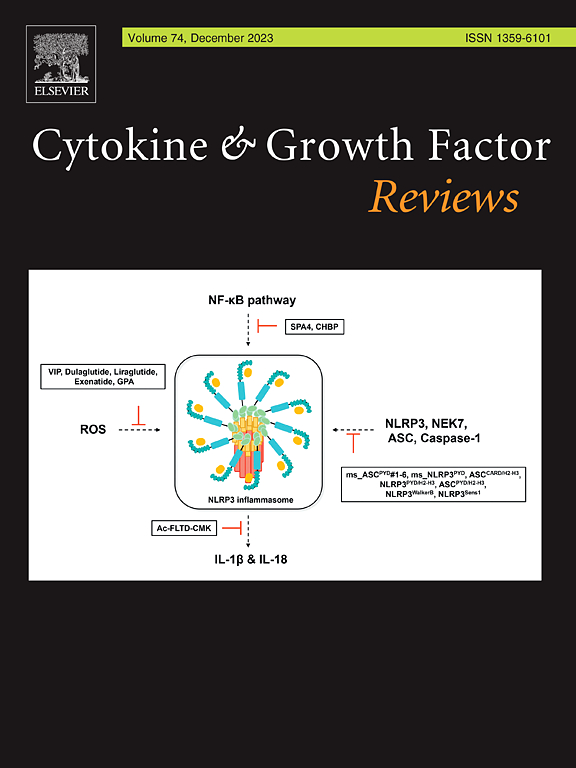The immunopathogenesis of a cytokine storm: The key mechanisms underlying severe COVID-19
IF 9.3
2区 医学
Q1 BIOCHEMISTRY & MOLECULAR BIOLOGY
引用次数: 0
Abstract
A cytokine storm is marked by excessive pro-inflammatory cytokine release, and has emerged as a key factor in severe COVID-19 cases – making it a critical therapeutic target. However, its pathophysiology was poorly understood, which hindered effective treatment. SARS-CoV-2 initially disrupts angiotensin signalling, promoting inflammation through ACE-2 downregulation. Some patients’ immune systems then fail to shift from innate to adaptive immunity, suppressing interferon responses and leading to excessive pyroptosis and neutrophil activation. This amplifies tissue damage and inflammation, creating a pro-inflammatory loop. The result is the disruption of Th1/Th2 and Th17/Treg balances, lymphocyte exhaustion, and extensive blood clotting. Cytokine storm treatments include glucocorticoids to suppress the immune system, monoclonal antibodies to neutralize specific cytokines, and JAK inhibitors to block cytokine receptor signalling. However, the most effective treatment options for mitigating SARS-CoV-2 infection remain vaccines as a preventive measure and antiviral drugs for the early stages of infection. This article synthesizes insights into immune dysregulation in COVID-19, offering a framework to better understand cytokine storms and to improve monitoring, biomarker discovery, and treatment strategies for COVID-19 and other conditions involving cytokine storms.
细胞因子风暴的免疫发病机制:重症COVID-19的关键机制
细胞因子风暴以过度的促炎细胞因子释放为特征,已成为严重COVID-19病例的关键因素,使其成为关键的治疗靶点。然而,其病理生理机制尚不清楚,阻碍了有效的治疗。SARS-CoV-2最初会破坏血管紧张素信号,通过下调ACE-2促进炎症。一些患者的免疫系统无法从先天免疫转变为适应性免疫,从而抑制干扰素反应,导致过度焦亡和中性粒细胞活化。这会加剧组织损伤和炎症,形成促炎循环。其结果是Th1/Th2和Th17/Treg平衡被破坏,淋巴细胞衰竭和广泛的血液凝固。细胞因子风暴治疗包括抑制免疫系统的糖皮质激素、中和特定细胞因子的单克隆抗体和阻断细胞因子受体信号传导的JAK抑制剂。然而,缓解SARS-CoV-2感染的最有效治疗方案仍然是疫苗作为预防措施,以及在感染的早期阶段使用抗病毒药物。本文综合了对COVID-19免疫失调的见解,为更好地理解细胞因子风暴,改善COVID-19和其他涉及细胞因子风暴的疾病的监测、生物标志物发现和治疗策略提供了一个框架。
本文章由计算机程序翻译,如有差异,请以英文原文为准。
求助全文
约1分钟内获得全文
求助全文
来源期刊

Cytokine & Growth Factor Reviews
生物-生化与分子生物学
CiteScore
21.10
自引率
1.50%
发文量
61
审稿时长
22 days
期刊介绍:
Cytokine & Growth Factor Reviews is a leading publication that focuses on the dynamic fields of growth factor and cytokine research. Our journal offers a platform for authors to disseminate thought-provoking articles such as critical reviews, state-of-the-art reviews, letters to the editor, and meeting reviews.
We aim to cover important breakthroughs in these rapidly evolving areas, providing valuable insights into the multidisciplinary significance of cytokines and growth factors. Our journal spans various domains including signal transduction, cell growth and differentiation, embryonic development, immunology, tumorigenesis, and clinical medicine.
By publishing cutting-edge research and analysis, we aim to influence the way researchers and experts perceive and understand growth factors and cytokines. We encourage novel expressions of ideas and innovative approaches to organizing content, fostering a stimulating environment for knowledge exchange and scientific advancement.
 求助内容:
求助内容: 应助结果提醒方式:
应助结果提醒方式:


